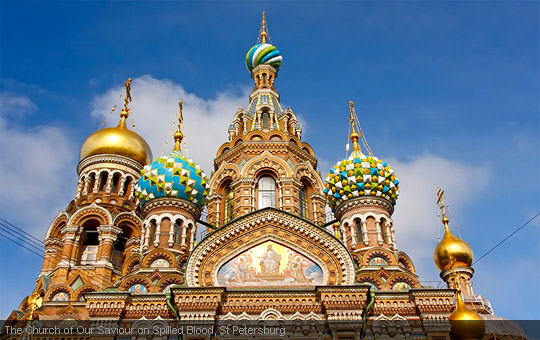Weather/ when to go:
Expect snow in the winter months, when the river Neva will often freeze and the city's attractions are sprinkled with snow and ice. This will start melting away by spring and the sunshine starts to reappear. Along with autumn, this can be a good time to beat the crowds and experience St Petersburg at a quieter time. Summer arrives in June and brings long days and evenings -- perfect for romantic boat rides on the canals. Night is at its shortest for the famous White Nights around summer solstice, during which it can last just a few hours.Do & see:
You won't be stuck for things to do and see in St Petersburg!The Winter Palace
Originally completed in 1735, the Winter Palace received several reconstructions and alterations over the next century or so and was damaged by fire in 1837. It was the main residence of the ruling Tsars until the assassination of Alexander II in 1881. Subsequent Tsars relocated to other areas but still used the Winter Palace for official ceremonies and receptions for a while. In 1917, it became part of the State Hermitage Museum and the State Rooms are a popular attraction with tourists.Address: Dvortsovaya nab 32
State Hermitage Museum
This is one of the largest museums in the world and contains over 3 million collection items. Unless there are items that are of particular interest, a guided tour is advisable to ensure that you at least see the highlights. Much of the collection is in the Winter Palace (former official residence of the Romanov Tsars) but there are other sites too.Address: Dvortsovaya nab 34
Monument to the Heroic Defenders of Leningrad
The monument was built in the 1970s in tribute of those who fought to defend the city against Nazi attack during the Siege of Leningrad in the Second World War. The main obelisk is part of a wider commemoration featuring an exhibition on the Siege and sculptures representing the heroic figures involved.Address: pl Pobedy
Nevsky Prospekt
The main street through St Petersburg is flanked by some of the city's most prestigious sights, such as the Kazan Cathedral (which was inspired by the Basilica of St Peter’s in Rome), a monument to Catherine the Great and the Anichkov Bridge (which features eye-catching equestrian statues). This is also the central shopping street in the city -- the Gostiny Dvor department store is here -- and something of an entertainment hotspot.Address: Nevsky Prospekt
Palace Square
Widely considered to be the main square in the city, Palace Square combines several different styles of architecture. On the northern side is the Winter Palace and across the square on the southern side is the former Imperial Army General Staff building, through which you can gain access to Nevsky Prospekt via the Triumphal Arch. The Alexander Column acts as a central focus point. Named after Emperor Alexander I, it stands as a monument to the Russian victory against Napoleon's French army.Address: Dvortsovaya Pl City Centre
The Church of Our Saviour on Spilled Blood
Built on the site on which Alexander II was assassinated in March 1881, the church is famed for its richly decorated façade and Russian-style onion domes, not dissimilar to that of the St. Basil's Cathedral in Moscow.Address: Griboedov canal embankment, 26, À
Russian Museum of Ethnography
Established in 1895 by Emperor Nicholas II and opened in 1898, the museum is a must-visit attraction if you love the arts. There are several sites -- Marble Palace, Benois Wing, Mikhailosky Palace, Mikhailovsky Castle, Stroganov Palace. These can all be accessed by taking the Metro to Nevsky Prospekt. Permanent exhibitions include Russian Art in the Context of World Art (Marble Palace), Art of the 20th century (Benois Wing), Mineral Study (Stroganov Palace) and Russian Art of the 18th century (Mikhailovsky Palace).Address: Inzhenernaya ul 4/1



